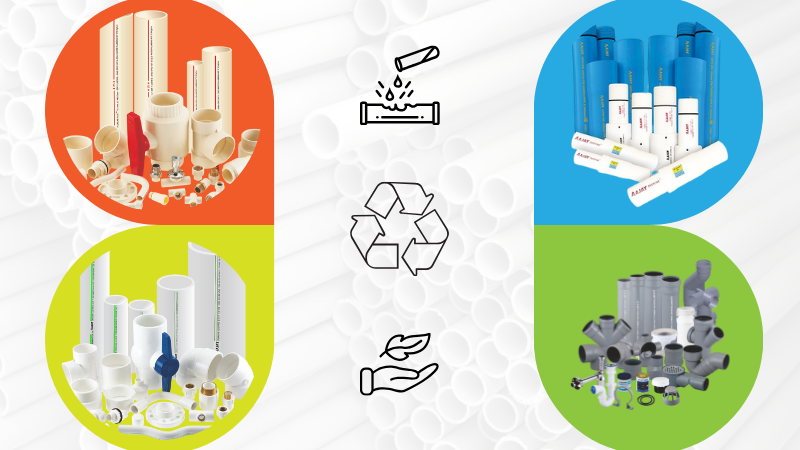Plastic pipes are lightweight, recyclable, easy to handle and install, resistant to corrosion, resistant to scaling, resistant to chemicals, resistant to microbial attacks hence they are cheaper to install and maintain and last very long. There are different types of plastic pipes in the market namely PVC pipes, CPVC pipes, UPVC pipes, Pex pipes, PERT pipes, PPR pipes, MDPE pipes, HDPE pipes, Composite Pipes, DWC Pipes & Biaxially Oriented PVC Pipes. Choosing the right plastic piping system depends on its chemical compatibility, temperature rating and pressure of the fluid used in the application.
Types of Plastic Pipes
PVC PLASTIC PIPES:
Polyvinyl Chloride (PVC) or Unplasticized Polyvinyl Chloride is a low carbon plastic used to manufacture pipes. PVC pipes are recyclable. They need less energy, few materials, and resources to manufacture and require less maintenance. PVC pipes are widely used in municipal water distribution systems, where water is drawn from sources like lake, river or stream and treated before it is distributed to homes and businesses. These are available in both solvent cement jointing and rubber ring jointing.
CPVC PIPING SYSTEM:
CPVC or Chlorinated Polyvinyl Chloride pipe is a thermoplastic polymer used for hot & cold water plumbing applications in residential, commercial and industrial buildings, They are produced as a result of chlorinating the PVC polymer. CPVC pipes are bendable and exhibit fire-retardant properties. Apart from being resistant to chemicals, CPVC is resistant to many acids, alcohols, hydrocarbons and bases. CPVC pipes are made in both CTS (Copper Pipe Size) and IPS (Iron Pipe Size) standards. Jointing of CPVC pipes and fittings done using solvent cements.
SWR PLASTIC PIPES:
SWR pipes are the PVC or UPVC pipes that are designed specifically for the drainage systems. SWR full form is Soil, Waste, and Rain. So technically SWR pipe is used for soil, waste, and rainwater drainage systems. The SWR drainage system is designed for quick and efficient removal of waste and debris without any blockage or leakage and is implemented in residential and commercial buildings. These are available with solvent jointing and rubber ring jointing.
UPVC PIPING SYSTEM
UPVC stands for Unplasticised PVC and is also known as rigid PVC. UPVC pipes and fittings are most commonly used for cold water plumbing system.They are light and easy to handle. They offer high mechanical performance, durability for a longer time, resistance to chemicals , UV exposure, and are 100% recyclable. The jointing system usually used for UPVc pressure pipes is solvent cement.
UNDERGROUND DRAINAGE PIPES
Underground drainage pipes are installed below the ground level to transport drainage or rainwater to a sewage treatment facility or a watercourse in case of rainwater. Underground drainage pipes are designed in such a way that they are highly robust and durable with high impact strength. These are also available in solvent and rubber jointing systems.
COLUMN PIPES
Column pipes are made of UPVC pipes and are used for borewell application. Column pipes are the best choice for piping solutions for irrigation, domestic, industrial and other infrastructural projects. The jointing is done using threaded connections making installation and maintenance easy.
AGRICULTURAL PIPES
Agricultural pipes are those PVC pipes placed into a trench that is backfilled with soil. The purpose of pipes is to help farmers source water from sources like rivers/ponds to the farms for irrigation purposes. Solvent cement is used for joining agricultural pipes.
HDPE PIPES
HDPE or High-density polyethene pipe is a flexible plastic pipe used for fluid and gas transfer. They have successfully replaced concrete and steel main pipelines. Made from the thermoplastic HDPE compound it is suitable for high-pressure pipelines owing to its strong molecular bond and high level of impermeability. These pipes are usually heat welded and sometimes use compression jointing also.
PPR PIPES
Made from polypropylene Random copolymer plastic, PPR pipes are straight and cylindrical pipes. They are produced through a continuous extrusion process. PPR can be used in hot and cold water as well as for purified drinking water systems.These utilize heat welding systems for jointing.
PEX PIPES
PEX pipes or Cross-linked polyethylene pipes is a plastic material used commonly for water supply piping systems. PEX pipes have successfully replaced copper, PVC and galvanized steel plumbing pipes since they offer several advantages. These pipes are flexible, offer high-heat resistance, durable and are easy to install. Most popular jointing system for PEX pipes involve crimping or compression systems.
PERT PIPES
PERT pipes are polyethylene (PE) pipes designed to withstand raised temperatures (RT). These pipes are extremely flexible and are ideal for plumbing, water service, hydronic heating and cooling and ground source geothermal piping systems. Like PEX, PERT also uses crimping or compression jointing systems.
COMPOSITE PIPES
Composite pipes are made of unreinforced thermoplastics like HDPE, PVC, PP, FRP (Fiber reinforced plastics) and GRP(glass reinforced plastics). They are resistant to corrosion and have stronger mechanical properties. Most popular jointing system for PEX pipes involve crimping or compression systems.
MDPE PIPES
MDPE or medium density polyethylene pipes are robust and are used to connect mains water & gas supplies into homes. They are installed in underground trenches dug in the virgin ground. MDPE pipes utilize the heat welding system for jointing.
DWC PIPES
DWC or Double Wall Corrugated pipes are manufactured using HDPE polymers. These pipes have a smooth internal surface and corrugated external surface and are durable. They have high resistance to corrosion and chemicals. DWC pipes are used for underground drainage systems.
BIAXIALLY ORIENTED PVC PIPES
PVC-O or biaxially oriented PVC is known a the latest evolution of PVC pipes. It is made by realigning the PVC molecules through a process of biaxial orientation. PVC-O pipes used for water distribution, fire & water saving irrigation.
Disclaimer: The opinion contained in this article is based on the research conducted and all the information and data were collected by genuine means from open-sourced portals and websites.
Download price list of pipes and fittings of various brands in India.

